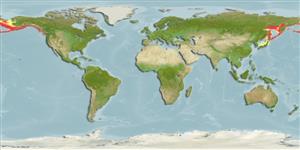Environment: milieu / climate zone / depth range / distribution range
Ecologia
marino demersale; distribuzione batimetrica 0 - 700 m (Ref. 50593), usually ? - 91 m (Ref. 2850). Temperate; 67°N - 35°N, 130°E - 125°W (Ref. 54599)
North Pacific: Korea and the Sea of Japan to the Sea of Okhotsk, Bering Sea, and Barkley Sound, Canada. Reported from the Alaskan Beaufort Sea (Ref. 28503).
Length at first maturity / Size / Peso / Age
Maturity: Lm 27.3, range 21 - 32 cm
Max length : 49.0 cm TL maschio/sesso non determinato; (Ref. 56370); common length : 33.5 cm TL maschio/sesso non determinato; (Ref. 4883); peso massimo pubblicato: 1.7 kg (Ref. 56527); Età massima riportata: 34 anni (Ref. 55701)
Spine dorsali (totale): 0; Raggi dorsali molli (totale): 61-69; Spine anali 0; Raggi anali molli: 48 - 58; Vertebre: 39 - 40. Dorsal origin above posterior part of eye. Caudal rounded at edges. Pectorals bluntly pointed.
Adults feed on hydroids, worms, mollusks, and brittle stars (Ref. 6885). Marketed frozen and eaten fried, microwaved and baked (Ref. 9988).
Each individual spawns from 8 to 11 batches (Ref. 39301). Spawning occurs primarily in shallow water but for large females spawning may take place in waters to a depth of around 50 m (Ref. 119537). Undergoes spawning and feeding migration (Ref. 119537).
Vinnikov, K.A., R.C. Thomson and T.A. Munroe, 2018. Revised classification of the righteye flounders (Teleostei: Pleuronectidae) based on multilocus phylogeny with complete taxon sampling. Molecular phylogenetics and evolution, 125:147-162. (Ref. 122998)
IUCN Red List Status (Ref. 130435)
Threat to humans
Harmless
Human uses
Pesca: elevato interesse commerciale; Pesce da pesca sportiva: si
Strumenti
Special reports
Download XML
Fonti Internet
Estimates based on models
Preferred temperature (Ref.
123201): 0.2 - 6.1, mean 3.4 °C (based on 33 cells).
Phylogenetic diversity index (Ref.
82804): PD
50 = 0.5156 [Uniqueness, from 0.5 = low to 2.0 = high].
Bayesian length-weight: a=0.00832 (0.00722 - 0.00958), b=3.08 (3.04 - 3.12), in cm total length, based on LWR estimates for this species (Ref.
93245).
Trophic level (Ref.
69278): 3.5 ±0.1 se; based on diet studies.
Generation time: 7.8 (6.8 - 11.0) years. Estimated as median ln(3)/K based on 12
growth studies.
Resilienza (Ref.
120179): Basso, tempo minimo di raddoppiamento della popolazione 4.5 - 14 anni (K=0.1-0.15; tm=4-10; tmax=34; Fec=1 million).
Prior r = 0.33, 95% CL = 0.22 - 0.50, Based on 5 stock assessments.
Fishing Vulnerability (Ref.
59153): Moderate to high vulnerability (50 of 100).
Climate Vulnerability (Ref.
125649): Low vulnerability (23 of 100).
Nutrients (Ref.
124155): Calcium = 12.4 [5.7, 51.3] mg/100g; Iron = 0.246 [0.127, 0.464] mg/100g; Protein = 15.7 [13.4, 18.4] %; Omega3 = 0.36 [0.18, 0.74] g/100g; Selenium = 13.5 [4.6, 46.8] μg/100g; VitaminA = 9.24 [1.88, 45.54] μg/100g; Zinc = 0.298 [0.160, 0.721] mg/100g (wet weight); based on
nutrient studies.
